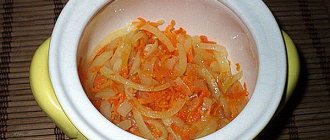The best lettuce varieties to grow at home
Batavia is considered the most suitable variety for an apartment . This is what they most often sell in grocery stores.
It grows even without additional lighting. Can withstand short-term drought and high air temperatures.
The most famous varieties for cultivation on the windowsill:
- Lollo Rossa
- Emerald lace
- New Year
- Lollo biond
- Vitamin
Lolla Rossa is distinguished by a brown head of cabbage and curly light green leaves. It is considered the most vitamin-rich . Has a delicate taste.
Lolla biond - the most beautiful . The leaves are wavy. Yellow-green color. The taste is pleasant, bitter with a nutty aftertaste.
Watercress is also grown in the apartment . This is a moisture-loving plant. The best varieties for the windowsill:
- curly;
- peppery;
- broadleaf;
- ordinary.
Broadleaf Cress
Selecting a container for sowing and preparing the soil
Lettuce roots do not go deep into the soil. Large containers are not needed for its growth. It is better to choose a plastic pot. The container should be 1–2 liters in volume . Depth – 10 – 35 cm. Depending on the variety. There should be holes at the bottom of the container.
Soil can be purchased at the store or you can use garden soil. Acidic soil is not suitable for planting. A better option is a mixture of turf soil, humus, and sand . Another option is garden soil, coconut fiber, vermicompost. The ratio of the last two is 2:1.
When using garden soil, the soil should be disinfected with a weak solution of potassium permanganate. The soil is filled into the pot, not reaching 2.5 - 3 cm to the edges.
Some varieties can be grown without soil . One of them is watercress. For cultivation, improvised materials such as sponge, cotton wool, and paper are used.
Some varieties of lettuce can be grown without soil - on paper or cotton wool
Sowing seeds
- Before sowing, seeds are disinfected in a solution of potassium permanganate. Time – 2-3 hours.
- A drainage layer is placed at the bottom of the pot.
- The drainage is covered with earth. Watered.
- They make a groove. Depth – 5 mm . The distance between rows is 10 cm .
- Seeds are placed in the groove. Cover with a small amount of earth. Lightly compact.
- Cover the container with a bag - create a greenhouse effect.
- Place in a dark place.
- When the first shoots appear, the bag is removed. Transfer to the windowsill.
The first shoots can be seen after 4 – 5 days . You need to protect it from direct sunlight. On bright sunny days it is necessary to shade it - the leaves can get burned.
The culture needs thinning . This is done 2 times:
- After 1 week, when the first shoots appear; It is necessary to leave a distance between them of 1–2 cm.
- When 2 true leaves are formed; Distance – 4–5 cm.
If the lettuce grows thickly, you will not be able to get a good harvest.
The salad needs to be thinned twice
Leaf salad
As a big salad lover, I couldn’t ignore it, of course. This crop is a little more demanding than green onions and watercress, but it’s worth the effort for the juicy greens. What to consider?
- Firstly , lettuce at home needs additional lighting - it is a light-loving crop. Lack of lighting will lead to early formation of flower stalks. The problem is partially solved by the choice of varieties. Lollo Rossa and Lollo Bionda (my favorites) performed well for me; New Year's, Vitamin, and Emerald Lace varieties are also recommended for home gardens.
- Secondly , lettuce reacts painfully to drought and heat: the leaves become coarse and bitter, and flower stalks quickly form.
- Thirdly , lettuce seedlings need to be thinned out. It is recommended to do this twice: a week after emergence, at a distance of 1-2 cm between seedlings, and in the phase of 2-3 true leaves - at a distance of 4-5 cm. If you thicken the crops, the plants will stretch out, weaken, and you will most likely harvest , you won't see.
Young leaf lettuce plants. Photo by the author It is better to avoid growing head forms of lettuce at home until you have enough experience: they are more demanding and require more careful care than their leafy counterparts, and their growing season, as a rule, is longer. To be honest, I didn’t even try to grow lettuce at home to the standard size it reaches in the garden - tender young leaves were enough for me. But, if the space allows, and there are conditions suitable for salad, it is quite possible to get large rosettes.
Harvesting
Greenery grows quickly. It can be collected over several weeks. The outer leaves are uprooted or torn off . After 3 - 5 weeks, arrows form. The plant is removed. Other seeds are sown in its place.
Experienced gardeners plant lettuce every 10 days . From one plant you get 40–50 grams of greens. But it all depends on the variety.
Leaf lettuce can be grown both in open ground and at home. But when planting it in an apartment, you need to remember that it requires daily care.
- This is a moisture-loving plant. The soil should always be slightly moist. But excess moisture can kill it.
- The best place is a window sill on the south, south-east side. It is impossible to grow it at home without sufficient light.
Grows quickly. Doesn't take up much space. But you need to choose the right variety for the pot.
In the era of proper nutrition and health care, more and more people are trying to grow their own vegetables in order to avoid chemical impurities in the finished product and not expose their body to danger. In this article you will read about lettuce - a true friend of any self-care person.
Parsley
Parsley can be obtained at home in two ways: by sowing seeds in the ground and by forcing them from harvested roots.
The second method, although it requires some preliminary preparation, is generally simpler. Even if you haven’t prepared planting material in the fall, you can look for high-quality root crops for forcing in the vegetable departments of stores. For our purposes, unconditionally healthy medium-sized parsley roots (30-60 g in weight) without signs of wilting are suitable. They must retain the apical bud - heavily pruned plants will not produce greenery. Having well moistened the soil in a box or flower pot, we plant root crops, covering their tops with soil. Too long ones can be cut off (the cut is sprinkled with coal to avoid rot) or planted at an angle. The latter option is considered even more preferable than the usual landing.
Parsley from seeds at home. Photo by the author
If you grow parsley from seeds, you need to take into account two nuances: the plant is light-loving, and its seeds germinate rather slowly. When sowing, the containers with parsley were not positioned very well relative to the light source, and the seedlings immediately began to stretch out. And it was possible to speed up germination by pre-soaking the seeds in Gumi solution (I will definitely tell you more about this wonderful preparation someday).
For more information about growing aromatic herbs at home, read the article How to grow parsley on a windowsill, and choose seeds in our catalog, which contains offers from various gardening online stores. Select parsley seeds :
Leaf parsley Delicate lace 16 RUR
Russian Vegetable Garden
Curly leaf parsley Kelly (multidragee) 41 rub.
Russian Vegetable Garden
Leaf parsley Crow's feet® 14 RUR
Russian Vegetable Garden
Common leaf parsley “Kolchuga NEW” 8 RUR
Russian Vegetable Garden
Parsley is not afraid of cold weather, so it feels great on the windowsill. The plant also does not have any special requirements for moisture - we water it as needed, depending on the conditions in the room. I traditionally apply hydrogel to all such plantings, so I usually don’t have any problems with watering my home garden.
Benefit or harm
Lettuce grown in a pot will bring exceptional benefits to the body. Which one?
Due to its low calorie content (12 kcal per 100 g), lettuce grown in a pot will not increase weight; it can be safely eaten in large quantities. Many nutritionists recommend consuming juicy leaves in combination with other products. After all, salad in its pure form does not make you feel full.
The rich vitamin and mineral composition of the salad cannot be ignored. It contains vitamins B and C, as well as potassium, calcium, sulfur, iodine, and phosphorus.
Also useful properties of the product include:
- improved digestion;
- normalization of intestinal function;
- cleansing the body of toxins;
- lowering cholesterol levels;
- improving the condition of hair and nails;
- improvement of skin, memory, vision;
- prevention of Alzheimer's disease.
However, there are also contraindications. It is not recommended to eat salad for people with gout, colitis and kidney problems.
Interesting method
I love fresh basil. I add it to pasta and the homemade pizza I make for my family, but when I buy it fresh cut or grown in a pot, it quickly withers and dies. However, I recently found a video on Youtube that demonstrates how quickly you can grow many plants from one basil plant.
So, from one plant you can get 8 seedlings in 30 days, then 18 in 60 days. In fact, if you did this for one year using this method, you could get a thousand basil plants, all from the original mother plant. The cutting and growing methods were not difficult to imitate.
Make a cut directly under the tuber with germinating buds. This is very important, since the juice enters the root from the flowering part of the plant. Then pinch off the side leaves from the bottom near the buds. Then place the cuttings in water and leave them in the sun for eighteen days. But it is not recommended that the sun constantly fall on the sprouts.
After 18 days, roots will appear on the sprouts. Transplant them into pots with fertilized soil; be sure to add some stones to the pots to drain water and ventilate the soil.
Place the pots on a window exposed to sunlight for twenty-one days. After this time, you will get amazing plants.
How to plant lettuce correctly
To plant leaf lettuce in a pot, choose plastic containers. Be sure to place a drainage layer of gravel or expanded clay at the bottom. It will help the water not to stagnate and protect the roots from rotting.
Use a special store-bought mixture. It is pest-free and enriched with nutrients necessary for lettuce to grow.
Garden soil can be infested with pests.
Sowing rules
Lettuce in a pot is planted in compliance with certain rules:
- The distance between rows is at least 10 cm.
- Sowing depth is no more than 0.5 centimeters.
- The soil must be thoroughly moistened before sowing.
- There should be a distance of 2-3 cm between the seeds.
- The pot is placed in a dark place and covered with glass or film to create a greenhouse effect.
- When shoots appear, the pot is exposed to light.
Growing lettuce in a pot is easy. It does not require special care. However, it is important to keep a few things in mind to ensure a bountiful and healthy harvest.
- Lighting. Windows facing southwest and southeast are the best choice. After all, a salad in a pot needs a lot of sun. In winter, additional artificial lighting is necessary. The daylight hours required for proper leaf formation are 9-14 hours. What can be done? You can use fluorescent lamps, placing them above the plants at a height of half a meter. If there is not enough light for the salad, the plant will stretch and turn white.
- Watering. It is necessary to moisten the soil as it dries. Use tap water for watering, but do not forget to let it sit for at least a day. Watering frequency increases as the lettuce grows.
- Temperature. Room conditions are quite suitable for salad. In winter, you shouldn’t leave the salad in a pot on the windowsill; the temperature next to the windows is always lower. Try to maintain a temperature of 15-20 degrees, the plants will feel comfortable. Do not let the thermometer drop below 5 degrees, otherwise the salad will freeze.
Watercress - care features
One of the most unpretentious species that provides the owners with a harvest already in the second week after germination. The only drawback is considered to be fragility, but this can be easily corrected by simultaneously sowing several containers at once with an interval of three to four days. In order for the watercress to green up the windowsill throughout the winter, it is recommended to pay attention to some care features.
Unlike other plants, it does not require special temperature conditions and grows well on a windowsill without additional insulation. It does not need an additional source of lighting, which is especially problematic for the cold season.
However, to ensure yourself a bountiful harvest, do not forget that: The species needs regular, abundant watering and air humidification. For the latter, it is recommended to carry out systematic spraying and place a container of water next to the pot to evaporate it and subsequently humidify the air.
This is especially important in winter, when almost every window sill has radiators that significantly dry out the air. If the moisture percentage is low, the leaves will begin to wither and their quality will deteriorate.
Seed germination occurs at a temperature of +7 +15 C. You can ensure this temperature in winter by simply placing the container on a covered balcony or windowsill.
To prevent the soil from drying out, the pot should be covered with polyethylene. As with other species, it should not touch the surface of the substrate.
Let's watch a video about growing watercress on a windowsill:
The first shoots will not keep you waiting; after the greens reach ten centimeters, they can be cut and consumed. Rich in nutrients, greens will become a real treasure for the cold season.
Salad on foam rubber
If you don’t want to tinker with the soil, there is an option to grow watercress. This species can be grown on foam rubber.
You will need deep trays, no lower than 5 cm. A 3 cm sheet of foam rubber is laid on the bottom, and paper towels are placed on top. Be sure to soak all contents with water. Seeds are poured into paper. The salad in a pot is ready and will grow no worse than in an earthen substrate.
After harvesting, the paper is removed, the foam is washed, and you can use it again and again.
The main condition: to grow lettuce in a pot in this way, the entire contents of the tray must be constantly moistened.
How to grow lettuce on a windowsill?
Earned: 3
When the summer period ends and we find ourselves in the city, we really want the flowering in the house to continue, and the greenery from the garden to continue to be present on the table.
And this can be achieved by creating your own beds at home.
You can grow quite a lot of different herbs at home.
Today we will look at the specific features of growing lettuce.
So, in order to grow lettuce on the windowsill, several conditions are necessary:
- Increased air humidity.
- Regular watering.
- Sunny place or backlight. To grow lettuce you need a fairly large container, about 1-2 liters, because... it grows quite large.
Soil is poured into the selected pot, not reaching 2-3 cm from the top of the container, all this is very well spilled with water so that the earth is completely wet, seeds are poured on top and sprinkled with a very thin layer of earth.
The finished pot is covered with film or glass and placed on a sunny windowsill.
But in cloudy weather, in winter, or in the absence of a window on the sunny side, it is necessary to use lighting, otherwise the seedlings will stretch out, and you will definitely not get a beautiful and lush salad.
In our case, we used a rack with LED lighting.
Of all the phyto-lamps that were tried, the most economically advantageous were those with which the GryadkiDoma complex was equipped; its illumination in the blue-red spectrum, in a ratio of 1:4, was perfectly perceived by all plants, and the LEDs did not burn the leaves, as, for example, they do ultraviolet lamps.
Once you have figured out how to provide light for the salad, it is very important to monitor the moisture content of the soil in the pot; you must always maintain balance and prevent the soil from drying out.
Until the sprouts have sprouted, the humidity is determined by the condensation that forms; if there is any, then everything is fine.
It is necessary to remove the film or glass at least once a day and let the sprouts breathe for a few minutes. If condensation stops forming, you need to carefully water the seedlings.
For watering, you can use a watering can with a narrow spout or a syringe, watering the soil along the edge of the pot, carefully so that it does not flow into the places where the seeds were sown. Or, what is best, keep a tray at the bottom of the pot, large enough to fill with water. So that the not yet strong seedlings do not bend under heavy drops of water (when watering from above), but are saturated with water from the bottom of the pot.
The scheme is simple: pour about 2-3 cm of water into the tray, let it stand for half an hour, during which time the water will rise through the capillaries of the earth and the humidity in the pot will increase. Then you can drain the water in the pan, and if the pot is tall, you can leave it.
When the first sprouts appear, it is important not to kill them with inept actions. Until they reach the level of the film or glass, keep them covered. If there is bright sun at this moment, they can cook, so you need to leave a gap in the film for air.
As soon as the sprouts reach the film, it must be removed and no longer put on, so that there is room for growth. Then all that remains is to monitor the soil moisture and spray the seedlings early in the morning or late in the evening with a spray bottle.
And after about a month you can enjoy the fresh leaves that you actually grew.
Harvest
It would seem that it would be easier than picking a ready-made salad? But if collected correctly, the bush will last a long time.
The salad is ready to eat a month after planting. Reaches 10 cm at home.
The lettuce is constantly growing, and to get as many leaves as possible, follow these simple rules:
- Collect leaves early in the morning, when the plant is saturated with moisture. This way the bush will grow healthy, and the collected leaves will remain strong and fresh longer.
- Don't cut off the middle. Harvest only the outer leaves of the lettuce in the pot. This way the lettuce will continue to grow and produce new leaves for several months.
- Collect once every 2 weeks to give the plant time to recover.
Lettuce leaves are stored well in the refrigerator for 5-8 days, maintaining their beneficial properties. Frozen food loses its taste when defrosted. This storage method is not recommended.
By sowing seeds every 1-2 weeks, you can provide the whole family with greens. Easy to care for and very healthy, salad in a pot deserves its place on the windowsill in your apartment.
And if you consider that, in addition to its undoubted nutritional benefits, lettuce is also beautiful, there is no doubt about the “to plant or not to plant” plan.
Growing an organically pure product, as can be seen from the article, is not at all fraught with difficulties. And it can grow all year round. Salad in a pot is an excellent solution for people who do not have a homestead, but want to eat healthy food.
A spring vegetable garden at home is a million in one: eco-style praised by the Scandinavians, saving on vitamins and entertainment for the whole family. We checked what you can easily grow on a windowsill, and what you’ll have to worry about a lot; where to make do with improvised means, and where it is better not to save; which plants should be grown from seeds, and which ones should be grown from leftovers not included in the salad.
How to grow salads at home?
ujanus proposed her idea and after a month of preparation... Reply Thread. Oh, where are my 17 years old, chips and Coca-Cola?! Reply Parent Thread.
Watercress
That's why I'm like an alcoholic. I can go a month without drinking and not remember, or I can go on a binge for a week:
I just put it in a glass and add water as it dries: It’s been tested, basil lives like this for 2 weeks. No, not a cut. I talked about the same hydroponic basil in a plastic flask and with roots. For comparison, it lives in the refrigerator for a week.
Today I will tell you how, without much hassle, you can grow a full-fledged salad on your windowsill, the same as from the supermarket in mini-pots in a matter of weeks. This method is the most viable, unlike planting lettuce from seeds, since the already formed root system of the plant is used. All large leaves of lettuce purchased in a pot are cut off and used for their intended purpose, so that a stem about cm high remains from the soil in the pot. Also, if there are small leaves, then it is better to leave them - they will later grow into large ones.
Well, you're confused. People, as far as I know, just like it's sold, poke this bunch into the water and the lettuce still grows little by little. Add to favorites. Read all the comments from the beginning: 1 2 3 4. I planted watercress a couple of times. Grows well. Finely chopped and mixed well with butter.
Very tasty for sandwiches. This year I decided to try basil: I planted several bushes from the garden in a flower pot. So far he's behaving normally. By spring, the leaves fall and after a while leaves and flower stalks appear again. It turns out that this plant is a perennial with red, yellow, lilac fruits, and looks like an ornamental tree.
Devices
You can grow fresh herbs at home without any special equipment at all, by planting seeds in packaging trays for vegetables and herbs, yogurt cups or containers from Doshik. However, for beauty and style, it is better to purchase special pots or boxes - wide, but not deep. It is convenient if they are equipped with special lids to create a greenhouse effect, although this can be achieved by simply covering the pot with plastic wrap or packing it in a transparent bag from the nearest “Magnet”.
The same principle applies to tools - you can dig in the ground with improvised means, but why, if for a decent mini-shovel and rake at Fix Price they only ask for 50 rubles? You will also need a spray bottle or watering can with a nozzle for “rain” and a bottle for settling the water - watering young greens with tap water is too harsh.
Photo shop: how to grow lettuce and greens in greenhouses
Is this a weed? Thank you, thank you everyone for the advice! First time on your page, I liked it. I also want to get the greens out for the New Year, although everything is frozen. For several years now I have been planting the miracle green everflora on the windowsill.
It's always nice to have fresh herbs on hand. What else can you grow for yourself on the windowsill?! Smells like advertising.
In general, for anyone who has never done this before, I don’t recommend it: it’s a waste of money on pots, soil, etc. Well, of course, there’s no talk about onions, stick any onion anywhere you want, it will grow.
Dill is completely useless, seven-centimeter cobwebs have grown, the trunk is like a needle. There is nothing to eat.
Although it was constantly illuminated, and besides, it was already spring. I suspect that nothing would have worked out in the fall, it would have only cost me a pretty penny for the light.
Preparation
Having stocked up with everything we need, we choose a place for the garden. Experts recommend a kitchen window sill - it is more humid and warm there than in rooms. However, before you trust expert opinion, decide on a list of plants: some (basil, oregano, spinach) really love light and warmth, while others (marjoram, watercress) need shade and coolness. These can be planted on a glassed-in loggia.
We plant each type of greenery in its own pot - not only because of differences in care and climate, but also because most plants cannot stand close proximity to others. If there is little space, but you want to plant a lot, it is better to use hanging pots or racks.
We fill the bottom of the pots with drainage and then lay out the soil. Its thickness depends on what we plant. The seeds can be soaked in a small amount of water for several hours - usually they are wrapped in gauze and placed in a saucer with water. The optimal moment for planting is when sprouts begin to emerge from the seeds.
Before planting, the soil is loosened, moistened, seeds are planted at the required depth, after which the soil is slightly compacted and watered again. Cover with a lid or plastic wrap until sprouts appear.
To prevent the plant from growing crookedly, leaning towards the window, the “bed” must be rotated 180 degrees daily. An alternative for the lazy is to attach foil to the pot, which will reflect sunlight.
Each gardener decides for himself whether to use fertilizers or not. Effective and at the same time safe options include ash, crushed banana peels, eggshells or yeast.
Starter level
Even a kindergartener can grow green onions, watercress or parsley on the windowsill. To plant watercress, you don’t even need soil: the seeds are placed in moistened cotton wool or paper towels. You can also do without a pot - a plate or tray will suffice. You need to sow densely so that the plants support each other. Press the seeds into a moist substrate and place on a lighted windowsill. It is important to maintain humidity, but not to flood. Salad does not like heat - the top temperature for it is 18 degrees. The harvest should be expected in 2-3 weeks. To renew the seedlings, you can either plant new seeds every 3-4 days, or sow a new tray every two weeks (this rule works for almost all plants grown from seeds).
Green onions can also be grown without soil. The bulb is placed in a glass of water so that only the root part is in the water. The water needs to be changed daily to avoid rotting. You can also transplant it into the ground - after the roots appear. There is no need to bury the bulbs entirely; you can plant them tightly - one to one. Celery is also grown through roots and water. The basis is not the root (which would seem logical), but the stalk from the leaf. After the roots appear in the water, it is transplanted into a pot and wait a couple of weeks until new leaves appear.
Watercress
I’ll say right away: I myself grew this plant only once - I was not impressed with its gastronomic properties. Personally, I liked mustard leaf better - also a very undemanding plant of the cruciferous family. But taste, as you know, is a purely individual thing, and I still take the liberty of recommending watercress as one of the best crops for home gardens. Why?
- Firstly , it - like onions - is extremely unpretentious. Those who do not have the opportunity or desire to spend time on labor-intensive care for the “beds” on the windowsill will certainly appreciate this, I think.
- Secondly , it is very early ripening: already 2-3 weeks after the emergence of shoots (and they won’t keep you waiting either) you will be pleased with young vitamin greens.
- Thirdly , nature has endowed watercress with many beneficial properties: regular consumption of this crop helps normalize blood pressure, improve digestion and sleep. It was used as a remedy for scurvy, and the juice was used to treat anemia and vitamin deficiencies.
Watercress - harvest in two weeks If you have children, try sowing watercress with them - at least for the sake of experiment.
This is one of those plants with which you should start getting into gardening, because failure is practically impossible! Watercress grows successfully on windowsills even in winter - it is very cold-resistant (the ideal temperature for it is considered to be from +15 to +18 degrees) and is not picky about light. The only thing it needs is regular moistening of the soil and air, since this plant does not like drought. To ensure that there is always greens on the table, it is advisable to sow another portion of watercress every 7-10 days .
I recommend reading more about growing watercress in the article How to quickly and easily grow watercress on a windowsill, and you can choose seeds in our catalog, which combines offers from large online stores of seeds and planting material. Select watercress seeds :
Spring watercress 14 RUR
Russian Vegetable Garden
Watercress salad Curled 58 RUR
Russian Vegetable Garden
Dansky watercress 14 RUR
Russian Vegetable Garden
Watercress Molniya 23 RUR
Russian Vegetable Garden











